The skin health supplement market enters a decade of measured expansion that will transform wellness and beauty applications across nutraceutical, cosmeceutical, and functional food sectors. The market's progression from USD 2,567 million in 2025 to USD 4,620.4 million by 2035 represents controlled growth, reflecting the accelerated adoption of beauty-from-within concepts and dermatological wellness technology across consumer health systems, personal care applications, and therapeutic wellness operations worldwide.
The first half of the decade (2025-2030) will witness the market climbing from USD 2,567 million to approximately USD 3,463.0 million, adding USD 896.0 million in value, which constitutes 44% of the total forecast growth period. This phase will be characterized by the continued adoption of collagen-based formulations and antioxidant systems, driven by increasing consumer health awareness and the growing need for comprehensive skin wellness solutions in beauty and health applications globally. Enhanced bioavailability technology and targeted delivery systems will become standard expectations rather than premium options.
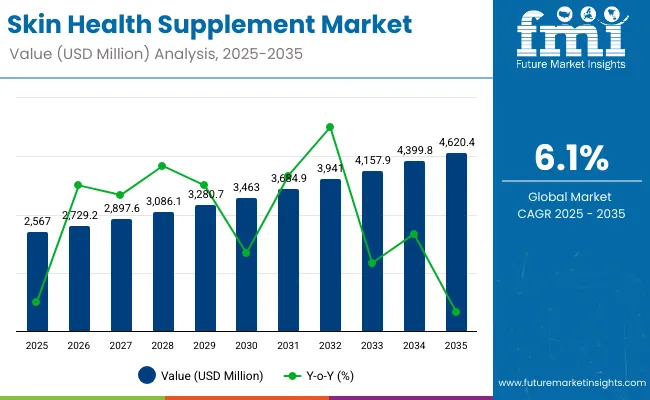
The latter half (2030-2035) will witness continued growth from USD 3,463 million to USD 4,620.4 million, representing an addition of USD 1,157.4 million or 56% of the decade's expansion. This period will be defined by mass market penetration of specialized skin wellness applications, integration with comprehensive health monitoring platforms, and seamless compatibility with existing beauty and wellness infrastructure. The market trajectory signals fundamental shifts in how consumers approach skin health management and wellness operations, with participants positioned to benefit from growing demand across multiple application segments and distribution channels.
Skin health supplement formulations encompass sophisticated bioactive delivery systems coordinating collagen synthesis, antioxidant protection, and nutrient absorption across diverse wellness and beauty applications. Collagen-based products demonstrate superior bioavailability through hydrolyzed peptide structures providing molecular weights between 2,000-5,000 daltons for optimal absorption characteristics. Manufacturing processes utilize advanced extraction and purification techniques maintaining bioactive compound integrity while ensuring product stability and efficacy throughout shelf life requirements.
Nutraceutical applications drive primary market demand through requirements for anti-aging benefits, hydration enhancement, and skin barrier optimization requiring consistent bioavailability and reliable therapeutic outcomes. Marine collagen formulations provide Type I collagen concentrations supporting dermal structure while maintaining compatibility with various delivery formats. Antioxidant complexes incorporate vitamin C, vitamin E, and polyphenol compounds providing cellular protection against oxidative stress and environmental damage.
Cosmeceutical applications leverage targeted ingredient combinations delivering visible skin improvements through oral supplementation systems. Premium positioning strategies emphasize clinical validation, dermatologist recommendations, and specialized health benefits justifying higher pricing compared to conventional beauty products. Processing innovations include microencapsulation technology, sustained-release formulations, and synergistic ingredient combinations ensuring optimal bioactive delivery and consumer satisfaction.
At-a-Glance Metrics
| Metric | Value |
|---|---|
| Market Value (2025) | USD 2,567.0 million |
| Market Forecast (2035) | USD 4,620.4 million |
| Growth Rate | 6.1% CAGR |
| Leading Product Type | Collagen-Based Segment |
| Primary Application | Nutraceuticals Channel |
The market demonstrates strong fundamentals with collagen-based formulations capturing a dominant share through reliable bioactive capabilities and wellness optimization. Nutraceutical applications drive primary demand, supported by increasing beauty awareness requirements and operational health development. Geographic expansion remains concentrated in developed markets with established wellness infrastructure, while emerging economies show accelerating adoption rates driven by beauty modernization initiatives and rising health accessibility standards.
Design for wellness versatility, not just ingredient content
Technology readiness for Beauty 4.0
Wellness-by-design approach
Value-based wellness models
Primary Classification: The market segments by product type into collagen-based antioxidants vitamins & minerals, herbal/botanical extracts, fatty acids, carotenoids and probiotic-based representing the evolution from basic wellness methods to specialized supplement applications for comprehensive skin health and beauty optimization.
Secondary Classification: Ingredient segmentation divides the market into collagen, vitamin C/E/biotin/zinc/selenium, omega-3/omega-6, carotenoids, hyaluronic acid polyphenols, and probiotics, reflecting distinct requirements for bioactivity efficiency, health reliability, and wellness processing infrastructure standards.
Tertiary Classification: Format segmentation covers capsules, tablets, gummies, powders, liquids/shots, and softgels, demonstrating varied delivery requirements and consumer preference standards.
The segmentation structure reveals technology progression from standard wellness methods toward specialized supplement applications with enhanced bioactivity consistency and health capabilities, while application diversity spans from beauty enhancement to therapeutic wellness requiring precise ingredient solutions.
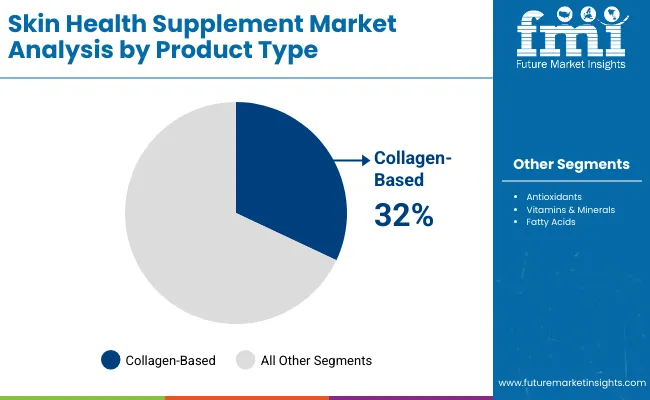
Market Position: Collagen-based formulations command the leading position in the skin health supplement market with 32% market share through advanced bioactive features, including superior absorption characteristics, operational efficiency, and wellness optimization that enable consumers to achieve optimal skin health across diverse beauty and wellness applications.
Value Drivers: The segment benefits from consumer preference for proven bioactive ingredients that provide consistent performance characteristics, reduced wellness complexity, and operational efficiency optimization without requiring significant lifestyle modifications. Advanced formulation features enable automated wellness monitoring systems, health tracking, and integration with existing beauty routines, where operational performance and health compliance represent critical consumer requirements.
Competitive Advantages: Collagen-based formulations differentiate through proven bioactive reliability, consistent wellness characteristics, and integration with automated health management systems that enhance skin effectiveness while maintaining optimal beauty standards for diverse wellness and beauty applications.
Key market characteristics:
Herbal/Botanical Extracts Applications Show Natural Market Growth
Herbal/botanical extracts maintain a 16% market position in the skin health supplement market due to their enhanced natural properties and wellness application characteristics. These systems appeal to consumers requiring specialized performance with premium positioning for beauty and health applications. Market growth is driven by wellness segment expansion, emphasizing natural beauty solutions and operational efficiency through optimized botanical designs.
Antioxidant Applications Demonstrate Protection Focus
Antioxidant formulations capture 14% market share through specialized protection requirements in anti-aging operations, cellular health applications, and wellness products. These operations demand certified bioactive systems capable of operating with beauty routines while providing effective protection integration and health performance capabilities.
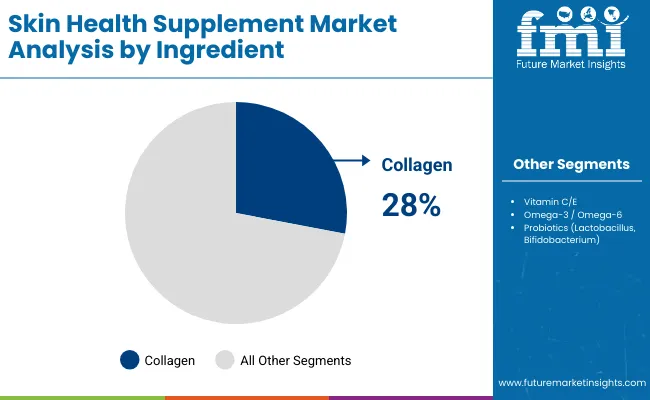
Market Context: Collagen ingredients demonstrate market leadership in the skin health supplement market with 28% share due to widespread adoption of bioactive wellness systems and increasing focus on operational cost efficiency, beauty processing optimization, and health applications that maximize wellness while maintaining beauty standards.
Appeal Factors: Beauty consumers prioritize ingredient consistency, operational efficiency, and integration with existing wellness infrastructure that enables coordinated beauty operations across multiple health applications. The segment benefits from substantial wellness investment and modernization programs that emphasize the acquisition of collagen-based systems for beauty optimization and health efficiency applications.
Growth Drivers: Wellness facility expansion programs incorporate collagen ingredients as standard components for beauty operations, while health growth increases demand for consistent bioactive capabilities that comply with wellness standards and minimize beauty complexity.
Vitamin/Mineral Complexes Maintain Nutritional Support
Vitamin/mineral complexes capture 18% market share through comprehensive nutritional requirements in beauty enhancement, wellness support, and health applications requiring reliable nutrient ingredients capable of operating within beauty routines while providing effective health integration and wellness performance capabilities.
Polyphenol Systems Show Antioxidant Growth
Polyphenol ingredients account for 12% market share, including cellular protection, anti-aging applications, and health wellness requiring specialized antioxidant solutions for beauty optimization and health accessibility.

Market Context: Capsule formats demonstrate market leadership in the skin health supplement market with 28% share due to widespread adoption of convenient delivery systems and increasing focus on consumer accessibility, wellness flexibility, and health applications that maximize convenience while maintaining bioactive standards.
Appeal Factors: Health consumers prioritize delivery convenience, operational flexibility, and integration with existing wellness infrastructure that enables coordinated health operations across multiple beauty applications. The segment benefits from substantial format investment and modernization programs that emphasize the acquisition of capsule-based systems for wellness optimization and health accessibility applications.
Growth Drivers: Consumer wellness expansion programs incorporate capsule formats as standard delivery for health operations, while beauty growth increases demand for consistent delivery capabilities that comply with wellness standards and minimize consumption complexity.
Application dynamics include:
Gummies Format Maintains Consumer Appeal
Gummies formats capture 22% market share through comprehensive taste requirements in consumer wellness, beauty applications, and convenience products. These operations demand appealing delivery systems capable of handling bioactive ingredients while providing effective consumer experience and health performance capabilities.
Tablets Format Shows Traditional Growth
Tablet formats account for 18% market share, including clinical applications, therapeutic wellness, and professional health requiring traditional delivery solutions for wellness optimization and bioactive accessibility.
| Category | Factor | Impact | Why It Matters |
|---|---|---|---|
| Driver | Beauty awareness growth & wellness demand (anti- aging requirements, skin health standards) | ★★★★★ | Large-scale beauty markets require efficient, reliable wellness solutions with consistent performance and health compliance across consumer applications. |
| Driver | Aging population expansion & health consciousness | ★★★★★ | Drives demand for specialized wellness solutions and high-efficacy bioactive capabilities; suppliers providing clinical-grade ingredients gain competitive advantage. |
| Driver | Social media influence & beauty trends (influencer marketing, wellness lifestyle) | ★★★★☆ | Consumer markets need accessible beauty solutions; demand for convenient formats expanding addressable market segments. |
| Restraint | Regulatory complexity & ingredient approval requirements | ★★★★☆ | Small brands face compliance pressure; increases cost sensitivity and affects ingredient consistency in budget-sensitive markets. |
| Restraint | Topical beauty competition & alternative wellness methods | ★★★☆☆ | Price-focused applications face challenges with ingredient selection and wellness requirements, limiting adoption in cost-sensitive segments. |
| Trend | Personalized nutrition & targeted wellness (custom formulations, individual health profiles) | ★★★★★ | Growing demand for personalized wellness solutions; custom formulation becomes core value proposition in health-focused segments. |
| Trend | Asian market expansion & regional beauty growth | ★★★★☆ | Regional wellness development drives demand for local beauty solutions; regional bioactive capabilities drive competition toward localization. |
The skin health supplement market demonstrates varied regional dynamics with growth leaders including France (6.9% growth rate) and UK (6.6% growth rate) driving expansion through beauty initiatives and wellness capacity development. Steady Performers encompass Germany (6.4% growth rate), China (6.3% growth rate), and India (6.0% growth rate), benefiting from established beauty industries and advanced wellness adoption. Mature Markets feature USA (5.3% growth rate) and Brazil (1.2% growth rate), where wellness technology advancement and consumer requirements support consistent growth patterns.
Regional synthesis reveals European and Asian markets leading adoption through beauty expansion and wellness development, while North American countries maintain steady expansion supported by technology advancement and regulatory requirements. Emerging markets show strong growth driven by beauty applications and wellness modernization trends.
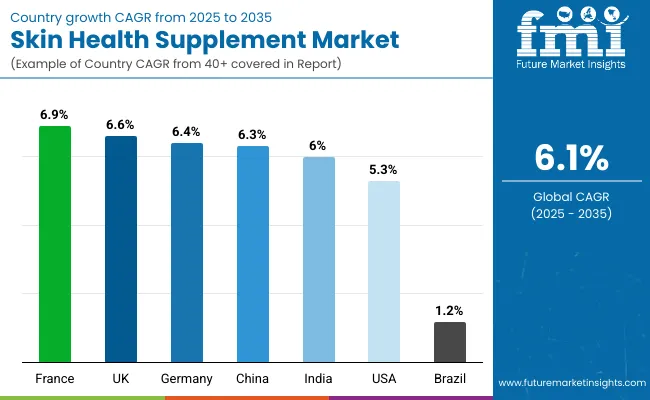
| Region/Country | 2025-2035 Growth | How to win | What to watch out |
|---|---|---|---|
| France | 6.9% | Premium beauty positioning | Facility precision; regulatory compliance |
| UK | 6.6% | Provide comprehensive wellness services | Brexit impacts; regulatory requirements |
| Germany | 6.4% | Premium quality positioning | Over-specification; regulatory compliance |
| China | 6.3% | Lead with high-volume wellness systems | Quality regulations; facility complexity |
| India | 6.0% | Focus on cost-effective beauty solutions | Infrastructure challenges; distribution availability |
| USA | 5.3% | Provide health-compliant applications | FDA regulations; facility requirements |
| Brazil | 1.2% | Push regional integration solutions | Economic conditions; infrastructure costs |
France establishes premium beauty growth through comprehensive wellness programs and advanced beauty infrastructure, integrating skin health supplements across consumer wellness facilities and beauty applications. The country's 6.9% growth rate reflects mature beauty industry relationships and established wellness adoption that supports widespread use of bioactive systems in beauty facilities and health-compliant operations. Growth concentrates in major beauty centers, including Paris, Lyon, and Marseille, where beauty technology showcases mature supplement deployment that appeals to consumers seeking proven wellness capabilities and operational beauty applications.
French distributors leverage established distribution networks and comprehensive beauty capabilities, including wellness programs and technical support that create customer relationships and operational advantages. The market benefits from mature beauty standards and EU requirements that support supplement system use while supporting technology advancement and operational optimization. Distribution channels through beauty retailers and wellness service distributors expand market access, while regulatory support for beauty development supports adoption across diverse consumer segments.
In London, Manchester, and Birmingham regions, wellness facilities and beauty operations are implementing advanced skin health supplements as standard components for beauty optimization and operational wellness enhancement, driven by increasing consumer beauty investment and wellness modernization programs that emphasize the importance of bioactive capabilities. The market holds a 6.6% growth rate, supported by beauty initiatives and wellness development programs that promote advanced bioactive systems for beauty facilities. British operators are adopting wellness systems that provide consistent operational performance and beauty compliance features, appealing in beauty regions where wellness efficiency and health standards represent critical operational requirements.
Market expansion benefits from growing beauty processing capabilities and wellness integration agreements that enable domestic production of advanced supplement systems for beauty applications. Technology adoption follows patterns established in wellness equipment, where efficiency and performance drive consumer decisions and operational deployment. British distributors leverage beauty capabilities and comprehensive wellness expertise, including supply programs and technical support that create customer relationships and operational advantages. The market benefits from established beauty standards and regulatory requirements that support wellness system use while supporting technology advancement and operational optimization.
Germany's advanced wellness technology market demonstrates sophisticated skin health supplement integration with documented operational effectiveness in premium beauty applications and modern wellness installations through integration with existing quality systems and beauty infrastructure. The country maintains a 6.4% growth rate, leveraging traditional quality expertise and precision systems integration in wellness technology. Beauty centers, including North Rhine-Westphalia, Bavaria, and Baden-Württemberg, showcase premium installations where supplement systems integrate with traditional quality platforms and modern wellness management systems to optimize beauty operations and maintain wellness quality profiles.
German distributors prioritize wellness precision and quality consistency in supplement development, creating demand for premium systems with advanced features, including quality monitoring and automated wellness systems. The market benefits from established quality infrastructure and commitment to beauty standards that provide long-term operational benefits and compliance with traditional quality wellness methods.
China establishes high-volume market development through comprehensive beauty programs and expanding wellness infrastructure, integrating skin health supplements across consumer wellness facilities and beauty applications. The country's 6.3% growth rate reflects growing beauty industry relationships and increasing wellness adoption that supports expanding use of bioactive systems in Chinese beauty facilities. Growth concentrates in major beauty centers, including Shanghai, Beijing, and Guangzhou, where wellness technology development showcases integrated supplement systems that appeal to Chinese consumers seeking advanced beauty capabilities and operational wellness applications.
Chinese distributors are developing high-volume wellness solutions that combine domestic distribution advantages with advanced operational features, including automated delivery systems and enhanced reliability capabilities. Distribution channels through beauty suppliers and wellness service distributors expand market access, while government support for beauty development supports adoption across diverse consumer segments.
India establishes cost-effective beauty development through aggressive wellness programs and comprehensive beauty capacity development, integrating advanced skin health supplement distribution as standard components in consumer beauty and wellness facility installations. The country's 6.0% growth rate reflects government initiatives promoting beauty modernization and wellness development capabilities that mandate the use of bioactive systems in beauty facilities. Growth concentrates in major wellness centers, including Mumbai, Delhi, and Bangalore, where beauty technology development showcases integrated supplement systems that appeal to consumers seeking advanced wellness capabilities and operational beauty applications.
Indian distributors are developing cost-effective beauty solutions that combine domestic distribution advantages with advanced operational features, including automated delivery systems and enhanced reliability capabilities. Distribution channels through wellness suppliers and beauty service distributors expand market access, while government support for beauty development supports adoption across diverse consumer segments.
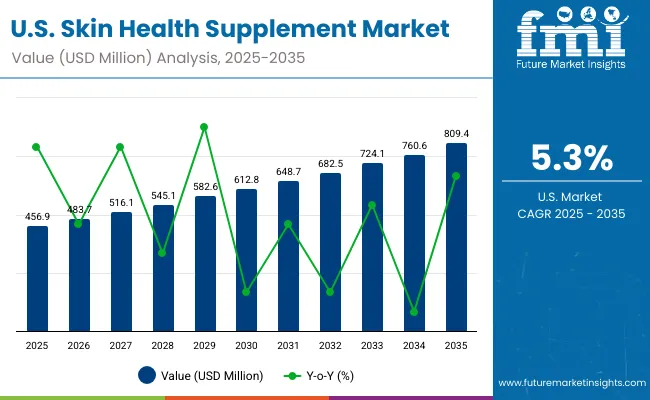
USA establishes health-compliant market development through comprehensive wellness programs and established health infrastructure, integrating skin health supplements across consumer wellness facilities and beauty applications. The country's 5.3% growth rate reflects mature wellness industry relationships and established beauty adoption that supports widespread use of bioactive systems in beauty facilities and health-compliant operations. Growth concentrates in major wellness centers, including California, New York, and Florida, where beauty technology showcases mature supplement deployment that appeals to consumers seeking proven health capabilities and operational beauty applications.
American distributors leverage established distribution networks and comprehensive wellness capabilities, including compliance programs and technical support that create customer relationships and operational advantages. The market benefits from mature health standards and FDA requirements that support bioactive system use while supporting technology advancement and operational optimization.
Brazil establishes regional integration development through beauty modernization and technology adoption, integrating skin health supplements across wellness facilities and regional beauty applications. The country's 1.2% growth rate reflects economic challenges and regional beauty investment that supports limited expansion of bioactive systems in Brazilian beauty facilities. Growth concentrates in major beauty areas, including São Paulo, Rio de Janeiro, and Belo Horizonte, where wellness technology development showcases regional supplement systems that appeal to Brazilian consumers seeking cost-effective solutions with beauty compatibility.
Brazilian distributors focus on maintaining regional standards while adopting wellness efficiency, creating demand for systems that balance performance with economic advantages. The market benefits from regional beauty infrastructure and growing wellness opportunities that support supplement technology adoption while maintaining economic standards important to Brazilian beauty applications.
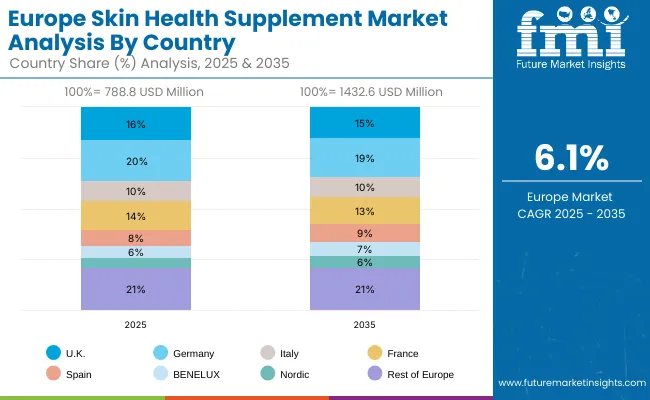
The European skin health supplement market is projected to represent a significant portion of global consumption, with strong regional distribution across major economies. Germany is expected to maintain its leadership position with USD 157.5 million in 2025, accounting for 22.5% European market share, supported by its advanced wellness infrastructure and major beauty centers.
United Kingdom follows with USD 126.0 million, representing 16% European market share in 2025, driven by comprehensive beauty programs and wellness technology development initiatives. France holds USD 110.3 million through specialized beauty applications and wellness compliance requirements. Italy commands USD 78.8 million, while Spain accounts for USD 63.0 million in 2025. The rest of Europe region maintains USD 165.4 million, attributed to increasing supplement system adoption in Nordic countries and emerging beauty facilities implementing wellness modernization programs.
| Stakeholder | What they actually control | Typical strengths | Typical blind spots |
|---|---|---|---|
| Global platforms | Distribution networks, broad wellness portfolios, manufacturing facilities | Proven reliability, multi-region support, comprehensive service | Technology refresh cycles; customer lock-in dependency |
| Technology innovators | R&D capabilities; advanced wellness systems; digital interfaces | Latest technology first; attractive ROI on specialized applications | Service density outside core regions; customization complexity |
| Regional specialists | Local sourcing, fast delivery, nearby technical support | "Close to site" support; pragmatic pricing; local regulations | Technology gaps; talent retention in wellness science |
| Application-focused ecosystems | Industry expertise, technical support, specialized solutions | Lowest application variation; comprehensive industry support | Scaling costs if overpromised; technology obsolescence |
| Service specialists | Delivery programs, wellness supply, technical training | Win service-intensive applications; flexible support | Scalability limitations; narrow market focus |
Key Players in the Skin Health Supplement Market
| Items | Values |
|---|---|
| Quantitative Units (2025) | USD 2,567 million |
| Product Type | Collagen-Based, Antioxidants, Vitamins & Minerals, Fatty Acids, Carotenoids, Herbal/Botanical Extracts, Probiotic-Based |
| Ingredient | Collagen (Type I, Type II, Marine, Bovine), Vitamin C/E/Biotin/Zinc/Selenium, Omega-3/Omega-6, Lycopene/Beta-Carotene/Lutein, Hyaluronic Acid, Polyphenols (Green Tea, Grape Seed), Probiotics (Lactobacillus, Bifidobacterium) |
| Format | Capsules, Tablets, Gummies, Powders, Liquids/Shots, Softgels |
| Function/Claim | Anti-Aging, Acne Control, Hydration & Elasticity, Skin Brightening, UV Protection, Wound Healing/Repair |
| Target Consumer | Women, Men, Teenagers, Seniors, Dermatology Patients |
| Distribution Channel | Pharmacies/Drugstores, Health & Beauty Retail Stores, Online Channels, Supermarkets/Hypermarkets, Direct-to-Consumer (D2C) |
| Application | Nutraceuticals, Cosmeceuticals, Functional Beverages, Nutricosmetics |
| Regions Covered | East Asia, Western Europe, South Asia Pacific, North America, Latin America, Middle East & Africa |
| Countries Covered | China, Germany, United States, Japan, India, South Korea, France, United Kingdom, Brazil, and 25+ additional countries |
| Key Companies Profiled | Nestlé Health Science, Amway, Shiseido, Blackmores, Herbalife Nutrition, Unilever, L'Oréal Nutricosmetics, Nature's Bounty |
| Additional Attributes | Dollar sales by product type and ingredient categories, regional adoption trends across East Asia, Western Europe, and South Asia Pacific, competitive landscape with wellness suppliers and service providers, consumer preferences for beauty consistency and operational reliability, integration with wellness platforms and health monitoring systems. |
The global skin health supplement market is valued at approximately USD 2,567 million in 2025.
The market is forecast to reach USD 4,620.4 million by 2035, expanding at a CAGR of 6.1% over 2025 to 2035.
Collagen-based formulations account for the leading share at around 32% of global revenue, driven by strong demand for clinically supported anti-aging and skin-strengthening benefits.
Capsules represent the leading delivery format with roughly 28% share, followed by gummies and tablets, reflecting the need for convenient, compliant, and dosage-consistent intake.
Nutraceutical applications dominate market demand, supported by rising consumer adoption of beauty-from-within solutions, anti-aging regimens, and daily skin wellness protocols.
Europe, South Asia Pacific, and East Asia are the key growth regions, with countries such as France, the United Kingdom, Germany, China, India, and Japan driving adoption through strong beauty cultures, expanding wellness infrastructure, and rising penetration of nutricosmetics.






Our Research Products

The "Full Research Suite" delivers actionable market intel, deep dives on markets or technologies, so clients act faster, cut risk, and unlock growth.

The Leaderboard benchmarks and ranks top vendors, classifying them as Established Leaders, Leading Challengers, or Disruptors & Challengers.

Locates where complements amplify value and substitutes erode it, forecasting net impact by horizon

We deliver granular, decision-grade intel: market sizing, 5-year forecasts, pricing, adoption, usage, revenue, and operational KPIs—plus competitor tracking, regulation, and value chains—across 60 countries broadly.

Spot the shifts before they hit your P&L. We track inflection points, adoption curves, pricing moves, and ecosystem plays to show where demand is heading, why it is changing, and what to do next across high-growth markets and disruptive tech

Real-time reads of user behavior. We track shifting priorities, perceptions of today’s and next-gen services, and provider experience, then pace how fast tech moves from trial to adoption, blending buyer, consumer, and channel inputs with social signals (#WhySwitch, #UX).

Partner with our analyst team to build a custom report designed around your business priorities. From analysing market trends to assessing competitors or crafting bespoke datasets, we tailor insights to your needs.
Supplier Intelligence
Discovery & Profiling
Capacity & Footprint
Performance & Risk
Compliance & Governance
Commercial Readiness
Who Supplies Whom
Scorecards & Shortlists
Playbooks & Docs
Category Intelligence
Definition & Scope
Demand & Use Cases
Cost Drivers
Market Structure
Supply Chain Map
Trade & Policy
Operating Norms
Deliverables
Buyer Intelligence
Account Basics
Spend & Scope
Procurement Model
Vendor Requirements
Terms & Policies
Entry Strategy
Pain Points & Triggers
Outputs
Pricing Analysis
Benchmarks
Trends
Should-Cost
Indexation
Landed Cost
Commercial Terms
Deliverables
Brand Analysis
Positioning & Value Prop
Share & Presence
Customer Evidence
Go-to-Market
Digital & Reputation
Compliance & Trust
KPIs & Gaps
Outputs
Full Research Suite comprises of:
Market outlook & trends analysis
Interviews & case studies
Strategic recommendations
Vendor profiles & capabilities analysis
5-year forecasts
8 regions and 60+ country-level data splits
Market segment data splits
12 months of continuous data updates
DELIVERED AS:
PDF EXCEL ONLINE
Pet Skin & Coat Health Supplement Market Analysis by Pet Type, Form, Availability and Sales Channel Through 2035
Skincare Supplement Market Size and Share Forecast Outlook 2025 to 2035
Healthy Aging Supplement Market – Demand, Innovations & Market Growth
Gut Health Supplement Market Size, Growth, and Forecast for 2025 to 2035
Bone Health Supplement Market Size and Share Forecast Outlook 2025 to 2035
Liver Health Supplements Market Analysis - Size, Growth, and Forecast 2025 to 2035
Brain Health Supplement Market Analysis - Size, Share, and Forecast Outlook 2025 to 2035
Immune Health Supplements Market Insights - Growth & Innovation 2025 to 2035
Women's Health Supplements Market Analysis - Size and Share Forecast Outlook 2025 to 2035
Cellular Health Supplement Market Size and Share Forecast Outlook 2025 to 2035
Hormonal Health Supplements Market – Growth, Demand & Nutritional Trends
Pet Joint Health Supplement Market Size and Share Forecast Outlook 2025 to 2035
Digestive Health Supplements Market Analysis - Size, Share, and Forecast Outlook 2025 to 2035
Postnatal Health Supplements Market Trends – Demand & Forecast 2025-2035
Cognitive health supplements market analysis by product type, form, sales channel, functionality, and by region – Growth, trends, and Forecast from 2025 to 2035
Postpartum Health Supplements Market Size and Share Forecast Outlook 2025 to 2035
Children’s Health Supplement Market Analysis by Product Type, Application and Age Group Through 2025 to 2035.
Kids’ Brain Health Supplements Market Size and Share Forecast Outlook 2025 to 2035
Older Adults Health Supplements Market Outlook - Growth, Demand & Forecast 2024 to 2034
Bone and Joint Health Supplement Market Analysis by Product Type, Form and Sale Channels Through 2035

Thank you!
You will receive an email from our Business Development Manager. Please be sure to check your SPAM/JUNK folder too.
Chat With
MaRIA